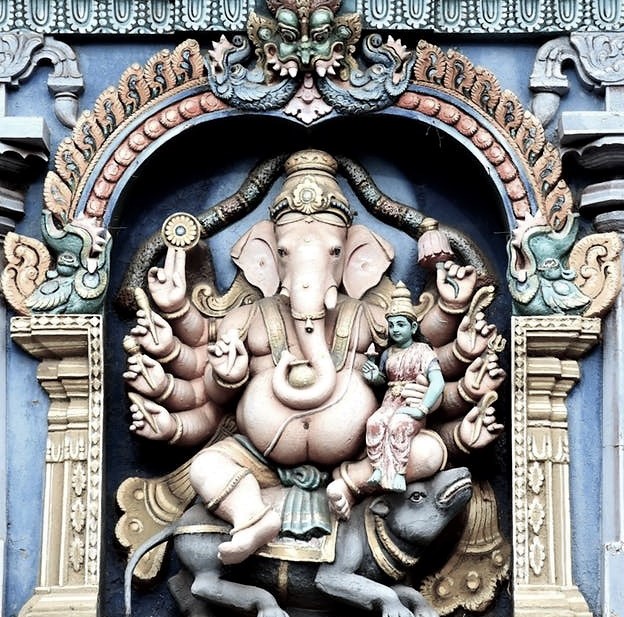- Special FeaturesFoundation Year1000 - 2000 years oldSthala TreePunnai TreeTheerthamKapali, Kadavul, Vada, Valli, Ganga, Velli, and Rama TheerthamsRathamArchitectureDravidian architectureOther SpecialityLord Shiva in the temple is a Swayambumurthi
- Sthala Puran
Mother Uma wanted to know the full meaning of the five lettered Mantra – Na Ma Shi Va Ya – and the glory of the sacred ash. She begged Lord Shiva to teach Her on these topics.
While Lord was teaching Her, Mother Uma was attracted by the beauty of a peacock dancing before Her. Lord, for Her inattention, cursed Her to become a peacock.
For relief from the curse, He advised Her to go to Earth and perform penance on Him. Mother Uma worshipped the Shivalinga under the Punnai tree in this place.
Moved by Her penance, Lord appeared before Her and confirmed Her release from the curse and named Her Karpagavalli. As requested by Mother Karpagavalli, Lord approved the name of the place Mayilai-now Mylapore.
Lord Shiva in the temple is Swayambumurthi.
Lord Brahma thought that He was as great and equal as Lord Shiva as He too had five heads as Shiva. To teach Him a lesson and to check His pride. Lord Shiva nipped one head and held the skull in His hand. Kapala in Sanskrit means skull, hence Lord Shiva was praised as Kapaleeshwara and the place KAPALEESHWARAM.
Vedas worshipped Lord Kapaleeswara, hence the place is known as Vedapuri. It is also known as Shukrapuri as planet Shukra-Venus worshipped Lord here. Lord Sri Rama stayed here, performed pujas to Lord Shiva with festivals.
The first piece of literature on this holy soil was the song of Saint Tirugnana Sambandar beginning with the line ‘Mattitta Punnayam Kanal’. These are the lines that brought Poompavai, daughter Sivanesar back to life, who died of snake bite while plucking flowers for Shiva Puja.
After cremating her body, Sivanesar preserved the bones and ashes in a pot. During the visit of Sambandar to the place, as required by the Saint, Sivanesar placed the ash-bone pot before him.
Sambandar sang a pathigam-10 verses, beginning with the line, ‘Mattitta Punnai’ listing the various festivals of Lord Shiva in the first three lines asking her in the final line, how she could miss the festivals dedicated to Lord Shiva. The pot broke off and Poompavai came alive in her full beautiful form.
The girl came alive after this song. Poompavai spent the rest of her life as a virgin serving Lord Shiva and attained salvation.
Before waging His war on demon Surapadma, Lord Muruga performed penance in this temple. Lord Shiva and Mother Uma blessed their Son and gifted the weapon VAEL to conquer the demon. Muruga returned triumphantly as Singaravelan on the demon peacock – demon Surapadma was changed to a peacock vahan of Muruga.
Indira gave his daughter Deivanai to Lord Muruga in marriage. Iravadham, elephant belonging to Indira, could not bear the separation of Deivanai and chose to stay with her.
As the divine Karpaga tree offers all wishes to a devotee, Mother Ambica offers all that Her devotees wish, hence praised as Karpakambika.
Lord Vinayaka is praised in the temple as Nardana Vinayaka-dancing Vinayaka.
Thalami, a researcher from Greece, visited this place 2000 years ago and had mentioned the name of the place as Malliarpa. This was the habitat of peacocks. As they made sounds – Arpu in Tamil – the place was known as Mayil (peacock) – Arpu, changed as Mayilappu and finally stayed with the name Mylapore.
Great Saivite Saints Tirugnana Sambandar, Tirunavukkarasar and Sundarar had sung the glory of Lord Kapaleeswara in their Thevaram hymns.
The commonly held view is that the temple was built in the 7th century CE by the ruling Pallavas. This view is based on references to the temple in the hymns of the Nayanmars (which, however, place it by a sea shore). Thirugnanasambandar's 6th song in Poompavaipathikam and Arunagirinathar's 697th song in Thirumylai Thirupugazh, make clear reference to the Kapaleeswarar temple being located on the seashore in Mylapore.
The scholarly view that accounts for the discrepancies is that the original temple was built on the shore but was destroyed by the Portuguese, and the current temple (which is 1-1.5 km from the shore) was built by the Vijayanagar kings during the 16th century, using some remains of the old temple.
There are inscriptions dating back to 12th century inside the temple. The temple's 120 ft gopuram was built during 1906 with stucco figures adorning it.
- Architecture
- Alankar of Deity
- Prayers and BenefitsSpecial Vratas and PrayersOfferings to DeityStotras and Mantras
- FestivalsPanguni PeruvizhaMarch - April
- Sodasha Upcharas
- Prasadhas
- Social ActivitiesAnnadhanMarriageEar BoringHead ShaveDanaasEducation FacilitiesSocial DrivesOther Activities
- Arjita Seva
- Tags

